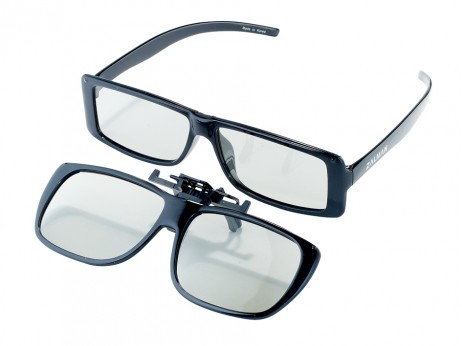NVIDIA has supported stereoscopic 3D for a long time before 3D Vision with things like 3D Discover, which used the old red/blue glasses trick to do 3D. In around 2008, they switched to shutter system built into the video drivers themselves. The basic idea was to have LCD glasses that could switch from clear to dark very quickly. The screen would show an image for the left eye while the right eye was blocked by the glasses, then the glasses would switch to block the left eye while the monitor showed a different image to the right eye. There was a little pyramid-shaped emitter to put on your desk that the video drivers would use to keep the glasses in sync without having to wire the glasses to the PC.
The technology worked very well! Especially as monitors got better, so the pixels on the screen could switch faster. (Earlier monitors wouldn't be able to change from bright color to dark fast enough, leaving a 'ghost' of the image still visible when the other eye got to view the screen. The moon caused that effect a lot.)
If you're thinking about how movies' 3D effects work, think again. 3D is goes by the triangulation using precise angles of where your eyes are pointed. If you move even a little closer to a nearby object, your eyes have to move, changing the angles. Movies have to try and make the effect work for a whole big room! Even TVs have to try and make it work for a living room. The only way they can do that is by making the effect pretty small. So maybe the distant mountain looks to be a couple of feet inside the screen. With 3D Vision, your head is only going to move around a little, so the effect can be fine-tuned to look real. A tower that's miles away looks like it's miles away. A gun pointed right at your nose will stick way out of the monitor! When the effect was working well (and your monitor was clean), it was hard to even figure out where the screen was without reaching out to touch it!
While the effect worked great, the games could sometimes be difficult. One common problem was particle effects. For instance, there would be a torch in the game. NVIDIA's drivers automatically worked with the 3D models in the game world and calculated the images for the left and right eyes so the torch itself looked fine. However, the flame would be calculated later as just a flat flame then placed at the x/y coordinates of where the torch is on the screen. In 2D, you're none the wiser. In 3D, the flame is much closer to you than the torch, and either to the right or left of the torch, depending on which eye was seeing it! Blah. Game developers rarely would fix this (3D Vision never got popular), but a team of modders would mess with shaders in much the same way as ReShade works and would often fix games.
Other games just don't fit well with 3D. Some are obvious - why use 3D Vision with a South Park game? Games with a lot of info on the HUD were a problem, too. If the HUD info was supposed to be above/around some 3D object (for instance, the name of a character hovering over the heads of people in MMOs), it will act like the torch flame and be in the wrong place. Even if it's just static screen stuff, like a hit point bar at the top of the window, you could get in trouble. Say your screen is 2ft away and you get your point of view so it's 1ft away from a book shelf. The triangulation tells you the book shelf is closer to you than the hit point bar, yet the hit point bar is covering up the book shelf, so it must be closer! Funky!!

Guns are a big problem, too, because games actually do them crazy. In real life, you would close an eye then put the gun in front of the other eye to look down the sights. In video games, you have only one eye, so you put the gun on your nose to look down the sights! 3D Vision makes it clear that's what's happening and it's about as hard to aim right with 3D Vision as it would be to aim when putting your gun on your nose. Modders would typically just push the targeting reticle way into the distance to fix the issue. Also, 3D Vision made it VERY easy to simply switch the system off with a keystroke, so you could turn off 3D Vision while in a gunfight, then turn it back on afterward.
When it was working well, 3D Vision was awesome! It's vastly more realistic when your eyes are properly seeing everything at depth. When you're taking Lara over a rope bridge in 2D, you can tell by all the visual cues that falling is going to kill you. When you do it with 3D Vision, IT'S A LONG DAMN WAY DOWN!!! Claustrophobia can even mess with you, if you need to crawl through some little cave while the next area loads.
NVIDIA even provided a way to save 3D screenshots. NVIDIA didn't mention it in any documentation, but the developers made it known in the forums. You could even pick if it used side-by-side JPG (.JPS) or side-by-side PNG (.PNS) files. Naturally, I loved this!

But 3D Vision never got popular. As I mentioned earlier, the monitors early on had some issues, plus people just didn't want to wear "dorky glasses" while playing. After 10 years, NVIDIA pulled it out of their driver updates and new video cards wouldn't support the system anymore.
It's up to Virtual/Augmented Reality to take over, now. VR has some definite advantages over 3D Vision. 3D Vision is confined to your monitor so, while the world looks much more real, you're still seeing it through a window. I just hope my screenshots can work in it.
The technology worked very well! Especially as monitors got better, so the pixels on the screen could switch faster. (Earlier monitors wouldn't be able to change from bright color to dark fast enough, leaving a 'ghost' of the image still visible when the other eye got to view the screen. The moon caused that effect a lot.)
If you're thinking about how movies' 3D effects work, think again. 3D is goes by the triangulation using precise angles of where your eyes are pointed. If you move even a little closer to a nearby object, your eyes have to move, changing the angles. Movies have to try and make the effect work for a whole big room! Even TVs have to try and make it work for a living room. The only way they can do that is by making the effect pretty small. So maybe the distant mountain looks to be a couple of feet inside the screen. With 3D Vision, your head is only going to move around a little, so the effect can be fine-tuned to look real. A tower that's miles away looks like it's miles away. A gun pointed right at your nose will stick way out of the monitor! When the effect was working well (and your monitor was clean), it was hard to even figure out where the screen was without reaching out to touch it!
While the effect worked great, the games could sometimes be difficult. One common problem was particle effects. For instance, there would be a torch in the game. NVIDIA's drivers automatically worked with the 3D models in the game world and calculated the images for the left and right eyes so the torch itself looked fine. However, the flame would be calculated later as just a flat flame then placed at the x/y coordinates of where the torch is on the screen. In 2D, you're none the wiser. In 3D, the flame is much closer to you than the torch, and either to the right or left of the torch, depending on which eye was seeing it! Blah. Game developers rarely would fix this (3D Vision never got popular), but a team of modders would mess with shaders in much the same way as ReShade works and would often fix games.
Other games just don't fit well with 3D. Some are obvious - why use 3D Vision with a South Park game? Games with a lot of info on the HUD were a problem, too. If the HUD info was supposed to be above/around some 3D object (for instance, the name of a character hovering over the heads of people in MMOs), it will act like the torch flame and be in the wrong place. Even if it's just static screen stuff, like a hit point bar at the top of the window, you could get in trouble. Say your screen is 2ft away and you get your point of view so it's 1ft away from a book shelf. The triangulation tells you the book shelf is closer to you than the hit point bar, yet the hit point bar is covering up the book shelf, so it must be closer! Funky!!

Guns are a big problem, too, because games actually do them crazy. In real life, you would close an eye then put the gun in front of the other eye to look down the sights. In video games, you have only one eye, so you put the gun on your nose to look down the sights! 3D Vision makes it clear that's what's happening and it's about as hard to aim right with 3D Vision as it would be to aim when putting your gun on your nose. Modders would typically just push the targeting reticle way into the distance to fix the issue. Also, 3D Vision made it VERY easy to simply switch the system off with a keystroke, so you could turn off 3D Vision while in a gunfight, then turn it back on afterward.
When it was working well, 3D Vision was awesome! It's vastly more realistic when your eyes are properly seeing everything at depth. When you're taking Lara over a rope bridge in 2D, you can tell by all the visual cues that falling is going to kill you. When you do it with 3D Vision, IT'S A LONG DAMN WAY DOWN!!! Claustrophobia can even mess with you, if you need to crawl through some little cave while the next area loads.
NVIDIA even provided a way to save 3D screenshots. NVIDIA didn't mention it in any documentation, but the developers made it known in the forums. You could even pick if it used side-by-side JPG (.JPS) or side-by-side PNG (.PNS) files. Naturally, I loved this!

But 3D Vision never got popular. As I mentioned earlier, the monitors early on had some issues, plus people just didn't want to wear "dorky glasses" while playing. After 10 years, NVIDIA pulled it out of their driver updates and new video cards wouldn't support the system anymore.
It's up to Virtual/Augmented Reality to take over, now. VR has some definite advantages over 3D Vision. 3D Vision is confined to your monitor so, while the world looks much more real, you're still seeing it through a window. I just hope my screenshots can work in it.








